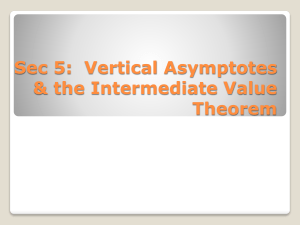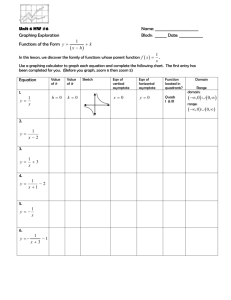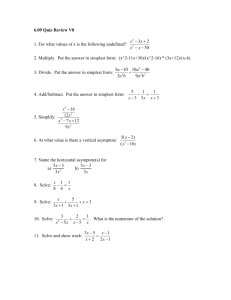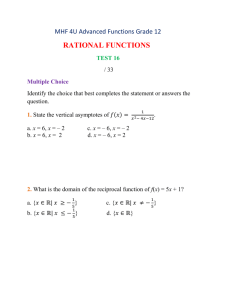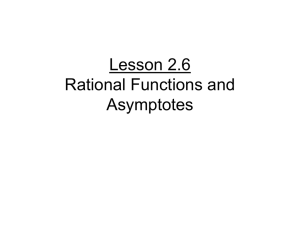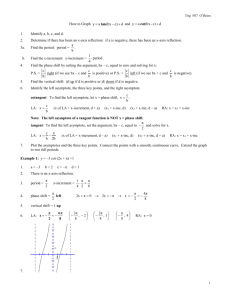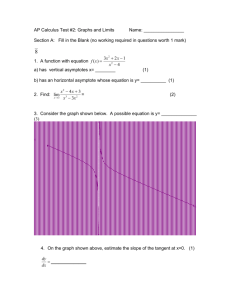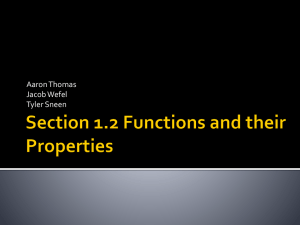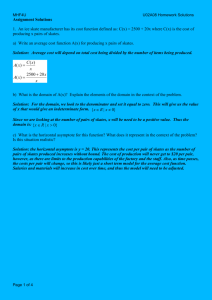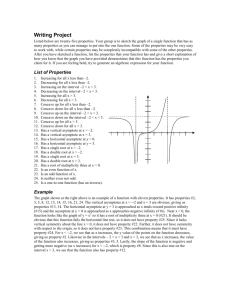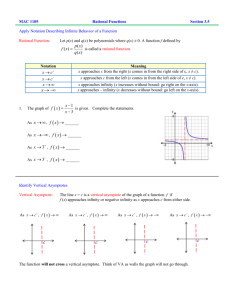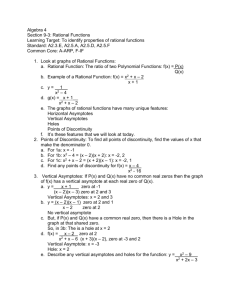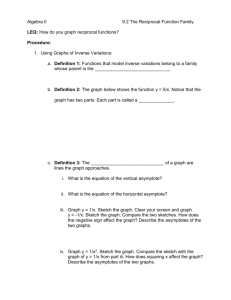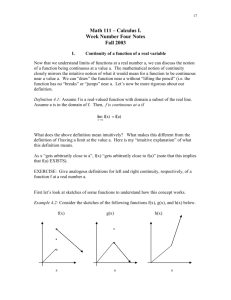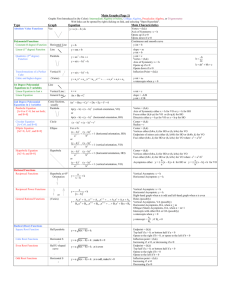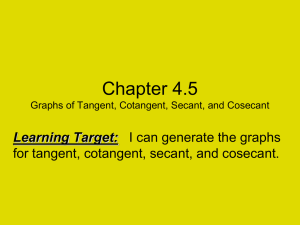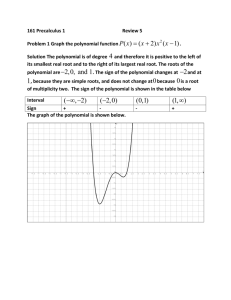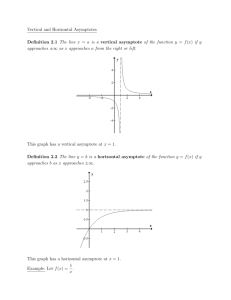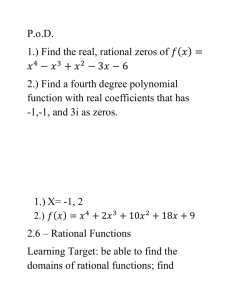(d) Use the Squeeze Theorem to show the line y = 0 is a
advertisement
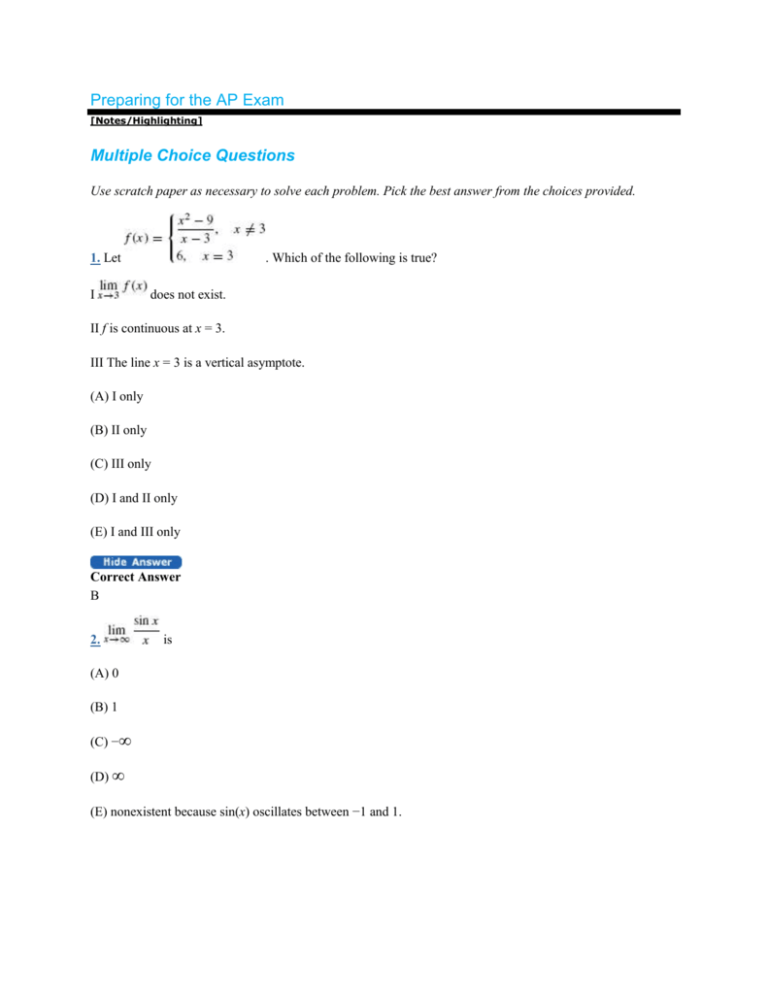
Preparing for the AP Exam [Notes/Highlighting] Multiple Choice Questions Use scratch paper as necessary to solve each problem. Pick the best answer from the choices provided. 1. Let I . Which of the following is true? does not exist. II f is continuous at x = 3. III The line x = 3 is a vertical asymptote. (A) I only (B) II only (C) III only (D) I and II only (E) I and III only Correct Answer B 2. is (A) 0 (B) 1 (C) −∞ (D) ∞ (E) nonexistent because sin(x) oscillates between −1 and 1. 3. is (A) 0 (B) (C) (D) (E) nonexistent Correct Answer C 4. Using the table of values of f (x), the average rate of change of f on the interval [−2, 4] is (A) (B) 1 (C) (D) (E) 12 5. Suppose be true? I f (2) = 5 II g (x) ≤ 6 for all x ≥ 2 III (A) I only (B) II only (C) III only , , and f (x) ≤ h (x) ≤ g (x) for all x. Which of the following must (D) I and III only (E) None of the statements must be true. Correct Answer E 6. If f is continuous on [2, 6], with f (2) = 20 and f (6) = 10, then the Intermediate Value Theorem says which of the following is true? I f (x) = 25 does not have a solution on [2, 6]. II f (x) = 17 has a solution on [2, 6]. III f (x) = 0 has a solution on [2, 6]. (A) I only (B) II only (C) III only (D) I and II only (E) I, II, and III 7. is (A) 0 (B) (C) (D) ∞ (E) −∞ Correct Answer E 8. (A) −∞ is (B) −3 (C) 0 (D) 3 (E) ∞ 9. is If f is continuous for all x, the maximum number of horizontal asymptotes that the graph of f can have (A) 0 (B) 1 (C) 2 (D) 3 (E) There is no maximum number. Correct Answer C 10. is If f is continuous for all x, the maximum number of vertical asymptotes that the graph of f can have (A) 0 (B) 1 (C) 2 (D) 3 (E) There is no maximum number. 11. (A) −∞ (B) −4 (C) −2 (D) 0 is (E) nonexistent Correct Answer C 12. If the graph of f has a tangent line for all x, with f (1.99) = 4.988 and f (2.01) = 5.004, then which of the following is the best approximation to the tangent line when x = 2? (A) y = 0.8x + 3.4 (B) y = 0.8x + 5 (C) y = 1.6x + 1.8 (D) y = 1.6x + 5 (E) y = 2.0x + 1 13. The graph of a function f is shown above. Which of the following is true? I II III (A) I only (B) II only (C) III only (D) I and II only (E) I, II, and III Correct Answer D 14. The graph of f given above has a tangent line at every x in (−2, 3) except x = (A) −1 (B) 0 (C) 1 (D) 2 (E) The graph has a tangent line at each x. 15. If the domain of f is [1, ∞) with f (1) = 0, and the line y = 3 is a horizontal asymptote for the graph of f, which of the following must be true? I The graph of f never meets the line y = 3. II III f is an increasing function. (A) I only (B) II only (C) I and II only (D) I and III only (E) I, II, and III Correct Answer B 16. is (A) −∞ (B) (C) 0 (D) (E) ∞ 17. If f is continuous on [1, 8] and some values of f are given in the table above, then which of the following must be true? I f (x) = −3 has a solution in [1, 8]. II f (x) = 0 has a solution in [1, 8]. III f (x) = 9 has a solution in [1, 8]. (A) II only (B) III only (C) I and II only (D) II and III only (E) I, II, and III Correct Answer D 18. is (A) −∞ (B) −1 (C) 0 (D) 1 (E) ∞ 19. If , then (A) 4 (B) 2 (C) 1 (D) 0 (E) nonexistent Correct Answer E 20. is (A) −∞ (B) −3 (C) 0 (D) 3 (E) ∞ Free Response Questions is Show all of your work and clearly label any functions, graphs, tables, or other objects that you use. On the AP, your work will be scored on the correctness and completeness of your methods, as well as your actual answer. You will usually not be given credit for answers that don’t include supporting work. 1. Let . (a) What is the average rate of change of f on the interval (b) What is ? ? (c) Is the line x = 0 a vertical asymptote of f? Justify your answer using limits. (d) Use the Squeeze Theorem to show the line y = 0 is a horizontal asymptote of f. Correct Answer (a) (b) (c) No, , so neither the left-hand limit nor the right hand limit is infinite, which is needed for the graph to have a vertical asymptote. (d) We know −1 ≤ sin x ≤ 1, so if x > 0, then Squeeze Theorem implies , and since , the . This means the line y = 0 is a horizontal asymptote. 2. Let (a) Are the lines x = 5 and x = −5 vertical asymptotes of f? Justify your answer. (b) Identify all horizontal asymptotes of f. Justify your answer. (c) Is there a value of A that makes f continuous at x = 5? (d) Is there a value of B that makes f continuous at x = −5? 3. 3. Let f (x) be a function defined for all x, with −5 ≤ f (x) ≤ 10. Also, does not exist but f (0) = (a) Let g (x) = xf(x). Show g is continuous at x = 0. (b) Does the graph of g have a tangent line at (0, 0)? Explain. Correct Answer (a) Since −5 ≤ f (x) ≤ 10, if x > 0 then −5x ≤ xf(x) ≤ 10x. Thus by the Squeeze Theorem . Next, if x < 0, then −5x ≥ xf(x) ≥ 10x. Applying the Squeeze Theorem again, . Thus . Checking the functional value, we have g (0) = 0 · 3 = 0. Thus , so g is continuous at x = 0. (b) No. 4. , which does not exist. Let . (a) Use the definition to show f is continuous at x = 4. (b) What is the average rate of change of f on the interval [0, 0.004]? (c) Is there an instantaneous rate of change of f when x = 0? Explain

